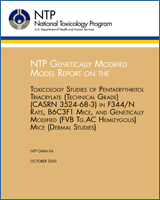This is a work of the US government and distributed under the terms of the Public Domain
NCBI Bookshelf. A service of the National Library of Medicine, National Institutes of Health.
Chhabra RS, Mahler J, Bristol DW, et al. NTP Genetically Modified Model Report on the Toxicology Studies of Pentaerythritol Triacrylate (Technical Grade) (CASRN 3524-68-3) in F344/N Rats, B6C3F1 Mice, and Genetically Modified (FVB Tg.AC Hemizygous) Mice (Dermal Studies): NTP GMM 04 [Internet]. Research Triangle Park (NC): National Toxicology Program; 2005 Oct.

NTP Genetically Modified Model Report on the Toxicology Studies of Pentaerythritol Triacrylate (Technical Grade) (CASRN 3524-68-3) in F344/N Rats, B6C3F1 Mice, and Genetically Modified (FVB Tg.AC Hemizygous) Mice (Dermal Studies): NTP GMM 04 [Internet].
Show detailsMethods
Rodents used in the Carcinogenesis Program of the National Toxicology Program are produced in optimally clean facilities to eliminate potential pathogens that may affect study results. The Sentinel Animal Program is part of the periodic monitoring of animal health that occurs during the toxicologic evaluation of chemical compounds. Under this program, the disease state of the rodents is monitored via serology on sera from extra (sentinel) animals in the study rooms. These animals and the study animals are subject to identical environmental conditions. The sentinel animals come from the same production source and weanling groups as the animals used for the studies of chemical compounds.
Serum samples were collected from randomly selected rats and mice during the 3- and 6-month studies. Blood from each animal was collected and allowed to clot, and the serum was separated. The samples were processed appropriately and sent to MA BioServices, Inc., or BioReliance Corporation (Rockville, MD) for determination of antibody titers. The laboratory serology methods and viral agents for which testing was performed are tabulated below; the times at which blood was collected during the studies are also listed.
| Method and Test | Time of Analysis |
|---|---|
| Rats | |
| 3-Month Study | |
| ELISA | |
| Mycoplasma arthritidis | Study termination |
| Mycoplasma pulmonis | Study termination |
| PVM (pneumonia virus of mice) | 4 weeks, study termination |
| RCV/SDA | |
| (rat coronavirus/sialodacryoadenitis virus) | 4 weeks, study termination |
| Sendai | 4 weeks, study termination |
| Immunofluorescence Assay | |
| Helicobacter hepaticus | Study termination |
| Hemagglutination Inhibition | |
| H-1 (Toolan’s H-1 virus) | 4 weeks, study termination |
| KRV (Kilham rat virus) | 4 weeks, study termination |
| Mice | |
| 3-Month Study | |
| ELISA | |
| Ectromelia virus | 4 weeks, study termination |
| EDIM (epizootic diarrhea of infant mice) | 4 weeks, study termination |
| GDVII (mouse encephalomyelitis virus) | 4 weeks, study termination |
| LCM (lymphocytic choriomeningitis virus) | 4 weeks, study termination |
| Mouse adenoma virus | 4 weeks, study termination |
| MHV (mouse hepatitis virus) | 4 weeks, study termination |
| M. arthritidis | Study termination |
| M. pulmonis | Study termination |
| PVM | 4 weeks, study termination |
| Reovirus 3 | 4 weeks, study termination |
| Sendai | 4 weeks, study termination |
| Immunofluorescence Assay | |
| H. hepaticus | Study termination |
| MCMV (mouse cytomegalovirus) | Study termination |
| Hemagglutination Inhibition | |
| K (papovavirus) | 4 weeks, study termination |
| MVM (minute virus of mice) | 4 weeks, study termination |
| Polyoma virus | 4 weeks, study termination |
| 6-Month Study | |
| ELISA | |
| Ectromelia virus | 4 weeks, study termination |
| EDIM | 4 weeks, study termination |
| GDVII | 4 weeks, study termination |
| LCM | 4 weeks, study termination |
| Mouse adenoma virus-FL | 4 weeks, study termination |
| MHV | 4 weeks, study termination |
| M. arthritidis | Study termination |
| M. pulmonis | Study termination |
| PVM | 4 weeks, study termination |
| Reovirus 3 | 4 weeks, study termination |
| Sendai | 4 weeks, study termination |
| Immunofluorescence Assay | |
| MCMV | Study termination |
| M. arthritidis | Study termination |
| Parvovirus | 4 weeks, study termination |
Results
One male and two female rats in the 3-month studies had a positive titer for H. hepaticus. Also, one male and one female rat in the 3-month studies were equivocal for H. hepaticus. For the 6-month studies in mice, all serology tests were negative.
- SENTINEL ANIMAL PROGRAM - NTP Genetically Modified Model Report on the Toxicolog...SENTINEL ANIMAL PROGRAM - NTP Genetically Modified Model Report on the Toxicology Studies of Pentaerythritol Triacrylate (Technical Grade) (CASRN 3524-68-3) in F344/N Rats, B6C3F1 Mice, and Genetically Modified (FVB Tg.AC Hemizygous) Mice (Dermal Studies)
- Same Parent, Connectivity for PubChem Compound (Select 165154298) (24)PubChem Compound
- Rattus norvegicus strain BN/NHsdMcwi chromosome 12, GRCr8, whole genome shotgun ...Rattus norvegicus strain BN/NHsdMcwi chromosome 12, GRCr8, whole genome shotgun sequencegi|2671914593|gnl|ASM:GCF_036323745 2|ref|NC_086030.1||gpp|GPC_000020855.1||gnl|NCBI_GENOMES|157501Nucleotide
- txid272561[Organism] (46030)GEO Profiles
Your browsing activity is empty.
Activity recording is turned off.
See more...